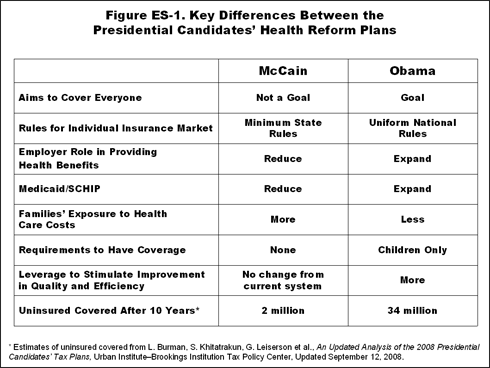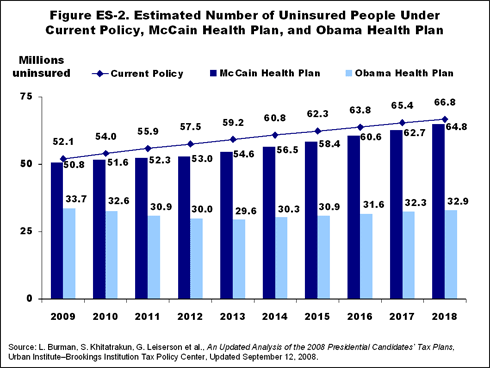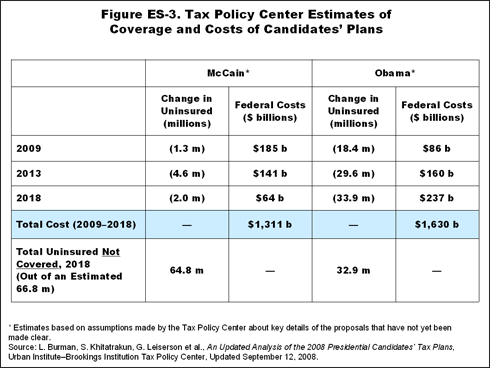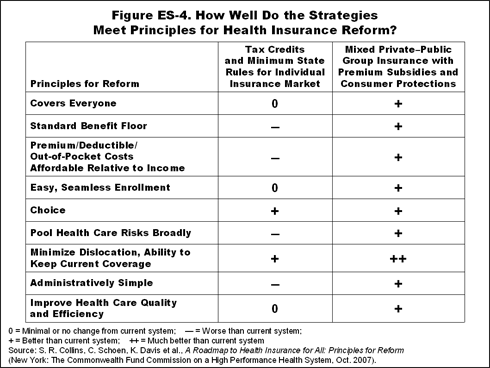Executive Summary
Introduction
With the 2008 presidential election just weeks away, health care reform is at the top of the nation's domestic policy agenda. The soaring costs of health care, along with a faltering economy and lackluster wage growth, are leaving many working families without insurance or with medical expenses that consume a large share of their incomes. A recent Commonwealth Fund study found that nearly two-thirds of working-age adults—an estimated 116 million people—either were uninsured for a time during 2007, were insured but had such high medical costs compared with their incomes that they were underinsured, reported a problem paying medical bills, or did not get needed care because of its cost. Over the past seven years, such problems have crept up the income scale among people with and without health insurance. Consequently, voters are calling for change: eight of 10 adults said in a May survey that the health care system is in need of a major overhaul or fundamental reform.
Both presidential candidates, Senator John McCain (R–Ariz.) and Senator Barack Obama (D–Ill.), have proposed plans to reform the health insurance system in the United States. They also have put forth ideas to improve the quality and efficiency of care. To inform the public discussion about possible paths to reform, this report describes the candidates' proposals, examines key differences in their vision of a future health insurance system, and evaluates the proposals against key principles outlined by the Commonwealth Fund Commission on a High Performance Health System.
Distinct Approaches to Health Care Reform
The presidential candidates' health care reform proposals offer fundamentally different visions of the future of health insurance in the United States. Both candidates propose reforms in which the health system would continue to be structured around private insurance markets, with a supporting role played by public insurance programs. But their plans diverge significantly on the way a reformed system should operate. McCain would change the tax code to encourage people to buy coverage through the individual insurance market and effectively loosen state rules governing the sale of insurance by allowing people to buy policies across state lines. Obama would encourage the continuing participation of employers in the health insurance system, expand eligibility for Medicaid and the State Children's Health Insurance Program (SCHIP), and create a new insurance market "exchange"—with consumer protections, choice of public and private health plans, and income-based premium subsidies—that would largely replace the individual market. According to one estimate, discussed below, in 10 years McCain's proposal would reduce the number of people who are uninsured by 2 million out of a projected 67 million. Obama's plan would reduce the number of uninsured people by 34 million in 10 years.
McCain's Approach: Tax Credits for Individual Market Insurance. McCain proposes to expand coverage through the individual insurance market by replacing the current tax exemption for employer-provided health benefits with tax credits of $2,500 for individuals and $5,000 for families. Currently, premium contributions from employers are not treated as taxable income to employees. Under McCain's proposal, these contributions would be subject to income taxes. People could use their tax credits to offset the costs of employer coverage or coverage purchased on the individual market, and could deposit any remaining funds in health savings account (HSAs). He also would effectively deregulate individual insurance markets by allowing people to buy coverage across state lines. He has proposed federal funding to expand existing state high-risk pools for people who cannot gain coverage through the individual market because of their health conditions, with premium assistance for those with lower incomes.
Obama's Approach: Private and Public Group Insurance with Consumer Protections and Income-Based Subsidies. Senator Obama has proposed a plan for universal coverage that would build on the current system of mixed private and public group insurance. Some of its features are similar to the universal coverage law now being implemented in Massachusetts. All employers, other than small businesses, would be required to offer health insurance to their employees or contribute to the cost. Eligibility for Medicaid and SCHIP would be expanded. Small businesses, self-employed individuals, and people who do not have coverage through their employers, Medicaid, or SCHIP would be able to purchase a plan through a new insurance market called the National Health Insurance Exchange. Through this exchange, people could choose a private plan or a new public plan similar to that offered to federal employees and members of Congress. All insurance carriers would be required to offer plans to all applicants and could not charge premiums based on health status. Small businesses would be eligible for tax credits to offset their premium costs and individuals would be eligible for income-based premium subsidies. Obama has not yet defined the size of eligible small businesses and those not subject to the requirement to offer coverage.
Key Differences Between the Candidates' Proposals
There are several differences between McCain and Obama's proposals to reform the health insurance system (Figure ES–1):

- Aiming to cover everyone. While McCain proposes to expand access to health insurance coverage, he has not said that covering everyone is a goal. Obama supports the goal of universal coverage.
- Minimum state rules vs. uniform national rules for the individual insurance market. Policies in the individual market are individually underwritten in all but a few states, making it difficult for older people or those with health problems to find coverage at affordable rates. Consequently, only about 7 percent of the under-65 population buys coverage in the individual market. This has changed little over time, despite the growing number of people who have lost access to employer-based health insurance. Individually underwritten policies increase administrative costs and reduce the potential for economies of scale. McCain would change the tax code to encourage more people to enroll in the individual market and allow people to buy policies across state lines. This would help people who currently buy coverage on the individual market by giving them a tax benefit. But allowing health insurance to be sold across state lines would effectively remove consumer protections now in place in some states, such as community rating and guaranteed issue. This would reduce access to insurance for older people and those with health problems and increase access for young and healthy people. McCain proposes to cover people with preexisting health conditions by using federal funds to expand high-risk pools, which now cover fewer than 200,000 people in 34 states. Obama, in contrast, would largely replace the individual market with an insurance exchange, in which small businesses and people without access to employer or public coverage could purchase a private health plan or a public plan with premium subsidies and tax credits. Insurers, including those selling policies outside the exchange, would be prevented from rejecting applicants or charging higher premiums because of preexisting conditions.
- Reducing vs. expanding the role of employers in providing health benefits. About 160 million people, more than 60 percent of the population under age 65, have insurance coverage through an employer. As stated above, McCain proposes to treat employers' contributions to employees' health insurance premiums as taxable income and provide tax credits for people to apply to their employer plans or to individual market plans. This change has the potential to reduce the incentive for many employers, particularly small employers, to continue providing health coverage to their employees. Obama's proposal would require all employers, other than small businesses, to offer coverage to their employees or pay part of the costs to cover them. This would allow most people to keep the coverage they have and maintain the more than $400 billion in employer contributions to health insurance currently in the system. He would provide tax credits to small businesses to buy coverage through the insurance exchange and would offer federal reinsurance for employers that experience catastrophic claims.
- Reducing vs. expanding Medicaid and SCHIP. McCain has said he would allow states to use Medicaid funds to enable purchase of private insurance by eligible families. To the extent that healthier Medicaid enrollees opted for private coverage, this option could fragment the program's risk pools into healthy and less healthy groups. Obama would raise income eligibility levels for Medicaid and SCHIP, allowing more people to join the programs. This would expand the large risk pools of Medicaid and SCHIP.
- More vs. less exposure to health care costs. McCain does not specify a standard floor for benefits and cost-sharing, which means that people buying coverage on the individual market with his new tax credits could face wide variations in their premiums, benefits covered, and out-of-pocket costs. He has said he would provide subsidies to help people with preexisting health conditions buy coverage in high-risk pools, though he has not specified the size of the subsidies or what household income levels would qualify. Obama would provide premium subsidies, on a sliding-scale based on income, for people to buy private or public plans through the insurance exchange; he has not specified the size of the subsidies or the eligible income levels. Obama would require that the public and private plans sold through the exchange have benefits and cost-sharing similar to that available to federal employees and members of Congress.
- No requirement vs. requirement to have coverage. McCain would not require that people have health insurance. Obama would require that children have health insurance and has said he would consider a similar requirement for adults if substantial numbers of people do not buy coverage that is deemed affordable.
- The same vs. more leverage to stimulate improvement in quality and efficiency. Both candidates have proposed conceptual approaches to improving the quality and efficiency of care. The candidates agree that: the U.S. should change the way providers are paid; care, especially chronic disease care, should be better coordinated and managed; and preventive services should be covered and easily accessed. However, their proposals for health insurance reform could significantly affect their ability to achieve improvements in quality and efficiency throughout the system. Both candidates point to public programs such as Medicare, Medicaid, and SCHIP as places to implement quality and efficiency initiatives, such as paying doctors and hospitals on the basis of quality. But because McCain's reforms would entail even less oversight of private insurance markets than we have today, he would be limited to implementing such initiatives in public programs. In contrast, Obama's proposed creation of a new public plan and an insurance exchange would provide new and larger arenas in which to experiment with quality and efficiency innovations. He has also identified the Federal Employees Health Benefits Program (FEHBP) as an insurance program in which innovations in quality and efficiency might be pursued. For example, providers and health plans participating in public programs and the exchange could be required to develop chronic disease management programs. The more organized insurance markets are and the more standardized the system is, the more leverage points there will be to make improvements in quality and efficiency.
How Many People Would Gain Health Coverage and What would It Cost?
The lack of detail in both candidates' proposals makes it difficult to estimate how many people would gain coverage under them and at what cost. Researchers at the Urban Institute–Brookings Institution Tax Policy Center made several assumptions about the proposals that enabled them to make the following preliminary estimates of the effects of the proposals on expanding coverage and the costs to the federal government over the next 10 years (Figures ES-2 and ES-3).


- If implemented in 2009, McCain's proposal is estimated to reduce the number of people who are uninsured by 1.3 million at a cost of $185 billion, though this does not include the effects of high-risk pools. About 20 million people would lose employer coverage under the McCain proposal, and 21 million would gain coverage in the individual market. Obama's plan is estimated to reduce the number of uninsured people by 18.4 million in 2009 at a cost of $86 billion.
- In the first year, McCain's plan is estimated to cost more than twice as much as Obama's while covering 17 million fewer people because most of McCain's tax credits would likely be used by people who already have private health insurance.
- By 2018, McCain's plan is estimated to reduce the number of uninsured by just 2 million out of projected 66.8 million uninsured at a cost of $64 billion. Obama's plan is estimated to reduce the number of uninsured by 33.9 million in that year at a cost of $237 billion.
- Over the 10-year period, the Center estimates that the total federal cost of McCain's plan could reach $1.3 trillion and the cost of Obama's plan could reach $1.6 trillion.
- McCain's proposal is estimated to cover fewer people in future years and cost less over time because the tax credits would grow at the rate of consumer prices, which have historically grown more slowly than medical expenditures. This means that, over time, the value of the tax credits is expected to decline relative to premium costs. This has two implications: 1) fewer people would be able to afford to buy health insurance with their tax credits and 2) people with employer coverage will pay more taxes on employer-provided premium contributions, thus offsetting the federal government's cost of the tax credits over time.
- The Center estimates that McCain's high-risk pool proposal, if adequately financed, could add another $1 trillion to the cost of his plan over 10 years. This feature is likely to be expensive for two reasons: 1) allowing people to buy coverage across state lines would remove existing consumer protections in some states, leading many people who currently have coverage through those markets to the high-risk pools and 2) many people with health problems who lose employer-based coverage under McCain's proposal would seek coverage in high-risk pools.
Which Proposal Holds the Greatest Promise?
To evaluate the candidates' proposals, the Commonwealth Fund Commission on a High Performance Health System identified several key principles for moving the health system toward high performance. They include:
- provision of equitable and comprehensive insurance for all;
- provision of benefits that cover essential services with appropriate financial protection;
- premiums, deductibles, and out-of-pocket costs are affordable relative to family income;
- health risks are broadly pooled;
- the proposals should be simple to administer, with coverage that is automatic and continuous;
- dislocation should be kept to a minimum—people could choose to keep the coverage they have; and
- financing should be adequate, fair, and shared across stakeholders.
Measured against these broad principles, Obama's proposal for mixed private–public group insurance with a shared responsibility for financing has greater potential to move the health care system toward high performance than does McCain's proposal to encourage individual market coverage through the use of tax incentives and deregulation (Figure ES-4). Compared with McCain's approach, Obama's approach could provide more people with affordable health insurance that covers essential services, achieve greater equity in access to care, realize efficiencies and cost savings in the provision of coverage and delivery of care, and redirect incentives to improve quality. In the absence of a requirement that everyone has affordable coverage, however, the proposal is likely to fall short of achieving universal coverage.

McCain's proposal to reform the health insurance system by relying on tax incentives and voluntary purchase of coverage in the individual insurance market with few ground rules is, by itself, unlikely to achieve universal coverage. Buying coverage in the individual market will continue to be challenging if tax incentives are not coupled with benefit standards, regulations against risk selection by carriers, and premium and out-of-pocket spending limits as a share of income. Insurers would still write individual policies rather than policies for a broad group of people. Moreover, because of the substantially higher administrative costs in the individual market, covering more people in this market would increase spending on insurance administration. Reliance on state high-risk pools to cover those denied policies in the individual market is also likely to be expensive.
Conclusion
Universal coverage is a necessary, though not sufficient, condition for improving the performance of the health system. Moreover, how policymakers design health insurance reforms will affect whether everyone can have affordable insurance that covers essential services and whether sustained improvements in quality and efficiency are achievable. As presidential candidates, Senators John McCain and Barack Obama propose reforms that would place the nation's health system on very different paths, with profound implications for the American people. In the wake of the 2008 election, it will be critical for policymakers to forge consensus around strategies for reform that have the greatest potential for success and move forward with pragmatic solutions to our worsening health system crisis.